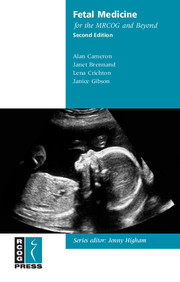Book contents
- Frontmatter
- Contents
- Preface
- Abbreviations
- 1 Screening for chromosomal abnormalities
- 2 Prenatal diagnostic techniques
- 3 The routine anomaly scan
- 4 Fetal structural abnormalities
- 5 Fetal therapy
- 6 Prenatal diagnosis and management of non-immune hydrops fetalis
- 7 Termination of pregnancy for fetal abnormality
- 8 Fetal growth restriction
- 9 Twin pregnancy
- 10 Fetal infection
- Index
1 - Screening for chromosomal abnormalities
Published online by Cambridge University Press: 05 August 2014
- Frontmatter
- Contents
- Preface
- Abbreviations
- 1 Screening for chromosomal abnormalities
- 2 Prenatal diagnostic techniques
- 3 The routine anomaly scan
- 4 Fetal structural abnormalities
- 5 Fetal therapy
- 6 Prenatal diagnosis and management of non-immune hydrops fetalis
- 7 Termination of pregnancy for fetal abnormality
- 8 Fetal growth restriction
- 9 Twin pregnancy
- 10 Fetal infection
- Index
Summary
Introduction
Screening for chromosomal abnormalities in an obstetric setting has traditionally meant screening for trisomy 21 (Down syndrome). Down syndrome has a livebirth incidence of approximately one in 700 and is the single most common cause of mental restriction in school-age children. It is associated with a spectrum of mental and physical handicap and, in view of this, strategies have been developed to identify those pregnancies at ‘high risk’ of the condition. This affords the opportunity for subsequent diagnostic testing and termination of an affected pregnancy, if chosen by the parents. Screening for trisomy 21 is offered routinely as part of antenatal care and forms the major focus of discussion for this chapter.
The success of a screening programme is not measured only by the number of affected pregnancies detected. Screening for trisomy 21 should be performed on an ‘opt-in’ basis and it is essential that parents who choose to enter a screening programme have adequate information about the implications and limitations of the test, so that they are not faced with results and decisions for which they are unprepared. Appropriate counselling is therefore paramount to ensure that parents for whom screening is inappropriate do not enter the programme.
A screening test simply places the individual in a ‘high-risk’ or a ‘lowrisk’ group. It does not tell us whether or not the condition being screened for is actually present. Thus, a woman who has a ‘high-risk’ screening test result for trisomy 21 would have to undergo a diagnostic test if she wished to establish whether or not the pregnancy was affected.
- Type
- Chapter
- Information
- Fetal Medicine for the MRCOG and Beyond , pp. 1 - 18Publisher: Cambridge University PressPrint publication year: 2011

